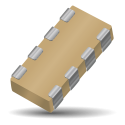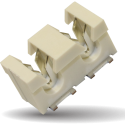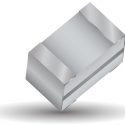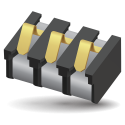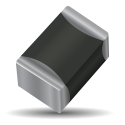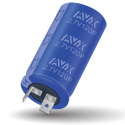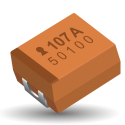Surface Mount Ceramic Resonators Written By: Phil Elliott Abstract: Ceramic resonators provide an attractive alternative to quartz crystals for oscillation frequency stabilization in many applications. Their low cost, mechanical ruggedness and small size often outweigh the reduced precision to which frequencies can be controlled, when compared to quartz devices. Ceramic resonators are now available in surface mountable packages suitable for automated production processes.
News / Events / Press
Comparison of Multilayer Ceramic and Tantalum Capacitors Written By: Jeffrey Cain, Ph.D. Abstract: Engineers now have a choice between ceramic and tantalum when it comes to selecting capacitors with values between 0.1 – 22µF. As the ceramic material technology continues to advance, more and more capacitance is realized in the same case sizes compared to previous years. This paper will examine what devices are available and the trade off of using each of the technologies. The goal of this work is to help in selecting the proper device (tantalum versus ceramic) for a specific application.
Capacitor Array — An Integrated Passive Component Offering Benefits to the Automotive Sector Written By: Mark Stewart Abstract: By combining discrete capacitors into a multi-element package, AEC-Q qualified capacitor arrays offer automotive designers the opportunity to lower placement costs, increase assembly line output through lower component count per board and reduce real estate requirements.
The 3 Rs of IDCs: Reliability, Repeatability, Reparability Written By: Tom Anderson Abstract: Even after more than 50 years in the marketplace, insulation displacement connectors (IDCs) continue to prove themselves in new and demanding applications, such as automotive safety systems, solid-state lighting (SSL), and industrial sensors and controls. IDCs have provided a cost-effective and reliable alternative to crimp-to-wire and hard-soldering wires to a PCB.
Optimizing Antenna Performance Through the Use of High Q, Tight Tolerance Capacitors Written By: Ron Demcko Abstract: Antenna matching is an important aspect of any RF system. Thinking in traditional terms, a properly designed and matched antenna increases the operating distance of the wireless product. Well matched antennas can transmit more power from the radio – therefore transmit over longer distances. Likewise, a well matched antenna allows the maximum transfer of energy from the receiving antenna to the receiver front end. Thus, allowing better receive characteristics for the system. But the use of a capacitor can also have a big impact upon the physical size of an antenna. If the goal is a compact, integrated antenna, the use of a
Portable Electronics Require Smaller, More Modular SMT Battery Connectors Written By: Tom Anderson Abstract: Next-generation battery connectors face many new market demands, although the common ingredients remain the same: high life cycle, stability, simple design, and SMT compatibility.
Aluminum Electrolytic Capacitor Holder For Ruggedized Automotive Applications Written By: Tom Anderson Abstract: Harsh environments such as automotive and industrial applications can be very demanding on larger electronic components, which are exposed to severe shock and vibration requirements. In order to protect these components, extra attention and most often times cost needs to be devoted to the processing and mechanical attachment within the device to the Printed Circuit Board (PCB).
The Frequency Response Effects of Internal Component Configuration on Multiple Ceramic Dielectric System Written By: S. Pala | R. Demcko | M. Berolini Abstract: The purpose of this paper is to discuss the frequency response effects of internal designs within ceramic systems. Those effects will be related to component performance parameters for devices used to suppress ESD and control EMI in high speed data lines, which are prone to be damaged by ESD. As communication speed increase, systems become more complicated and performance standards tighten, options to improve EMI/RFI performance becomes of great importance. Long term EMI performance and reliability are of particular importance in automotive, medical and aviation application sectors. A performance comparison will be made between single element
SMT Process Characteristics of AVX TransGuards Written By: Ron Demcko Abstract: TransGuards are uniquely suited for wide-scale usage in SMT applications. TransGuards exhibit many advantages when used in SMT assemblies. This paper is a general guideline aimed at familiarizing users with the characteristics of soldering multilayer SMT ZnO TransGuards.
LCD Driver Circuit EMI Filtering Options Written By: Ron Demcko Abstract: A review of EMI filter component options, comparing product performance, device characteristics and related factors (eg PCB board area, placement cost, etc.).
Charge Control Methods for SuperCapacitors: Methods to Protect Power Sources from Damage Due to High Current Demands of SuperCapacitors Written By: Ron Demcko | Joe Hock | Ashley Stanziola | Daniel West Abstract: Circuit designs exploiting the increased energy storage provided by supercapacitors, requires careful consideration of the increased power handling, than that of batteries, when charging these devices. The unique composition of electrochemical double-layer capacitors (EDLC) inherently allows them to withstand large currents. Table 1 below is a brief list of AVX cylindrical (SCC) and series-connected module (SCM) SuperCapacitors, displaying peak current supply and sink current capability. These maximum specifications will typically exceed current capability of charge sources, and lead to failures within the power supply system. Supercapacitors have
Equivalent Circuit Model for Tantalum and Niobium Oxide Capacitors for use in Simulation Software Written By: J. Pelcak Abstract: In electrical circuit simulations with simulation software, ideal passive components (resistors, capacitors, inductors) are typically used because real component characteristics have been difficult to model. Unfortunately, ideal and real passive components have significant differences in their electrical behavior. These differences lead to discrepancies between actual hardware performance and expected results based upon simulation software programs. This paper will describe the development of equivalent circuit diagram for modeling real capacitor behavior. Use of this real model in simulation software can help make circuit development more efficient, as the circuits in the simulations should have similar behavior to the actual circuits. The model
How to Choose the Correct Accu-Guard Fuse for Circuit Protection Written By: Irina Daynov | Barry Breen Abstract: The ACCU-GUARD is designed to meet the need of electronic circuits for a small, accurate surface mount fuse. This article presents design guidelines for achieving optimal protection of circuits with ACCU-GUARD. All major parameters are described including operating temperature, circuit voltage, fault current, steady state current and current pulses (Joule integral).
Capacitor Selection and EMI Filtering Written By: Jeffrey Cain | Steve Makl Abstract: MLCCs are an inexpensive, yet effective, method for reducing the noise on both power/ground systems and signal lines themselves. Choosing the proper capacitance value such that the impedance is minimized at the frequency of interest also makes a difference.
Conductivity Mechanisms and Breakdown Characteristics of Niobium Oxide Capacitors Written By: J. Sikula | J. Hlavka | V. Sedlakova | L. Grmela | P. Hoeschl | T. Zednicek | Z. Sita Abstract: Niobium Oxide capacitor, has already found its place in the market as a cost effective and reliable non-burning component. The study of conductivity mechanisms has been done to prove its excellent stability, reliability and non-burning performance. Set of electrical measurements as VA characteristics in forward and reverse mode, frequency characteristics of capacitance, temperature or time dependence of basic parameters together with measurements of basic physical parameters enabled to propose the theoretical model of NbO – Nb2O5 – MnO2 system. NbO Capacitor shows identical conductivity mechanism as tantalum capacitor,
AVX Staticguard Performance Comparison to SOT-23 SMT Diodes Written By: Ron Demcko Abstract: AVX StaticGuard is designed to provide transient protection for MSI to VLSI CMOS circuitry. This article presents performance characteristics of low energy MLV transient voltage suppressors relative to low energy silicon diodes. All major parameters are described, including leakage current, clamping voltage, capacitance, peak current and repetitive strike performance. AVX StaticGuard is shown to have superior performance to SOT 23 diodes in transient suppression applications.

